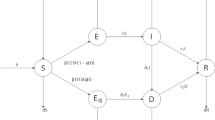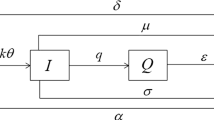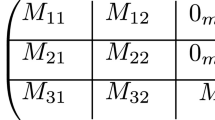Abstract
We consider the susceptible-exposed-infected-removed (SEIR) epidemic model and apply optimal control to it successfully. Here three control inputs are considered, so that the infection rate is decreased and exposed or infected individuals are removed. Our approach is to reduce the computation of the optimal control input to that of the stable manifold of an invariant manifold in a Hamiltonian system. Some numerical examples in which the computer software AUTO is used to numerically compute the stable manifold are given to demonstrate the usefulness of our approach for the optimal control in the SEIR model. Our study suggests how we can decrease the number of infected individuals quickly before a critical situation occurs while keeping social and economic burdens small. Our results for the SEIR model are very different from the previous one for the SIR model, which is similar but simpler than the present one.










Similar content being viewed by others
Data availability
The datasets generated during and/or analysed during the current study are available from the corresponding author on reasonable request.
References
Arnold, V.I.: Mathematical methods of classical mechanics, 2nd edn. Springer, New York (1989)
Bentaleb, D., Harroudi, S., Amine, S., Allali, K.: Analysis and optimal control of a multistrain SEIR epidemic model with saturated incidence rate and treatment. Differ. Equ. Dyn. Syst. (2022). https://doi.org/10.1007/s12591-020-00544-6. (in press)
Brauer, F., Castillo-Chavez, C.: Mathematical models in epidemiology. Springer, New York (2019)
Doedel, E., Oldeman, B.E.: AUTO-07P: Continuation and bifurcation software for ordinary differential equations. (2012), available online from http://cmvl.cs.concordia.ca/auto
Grigorieva, E., Khailov, E., Korobeinikov, A.: Optimal control for an SEIR epidemic model with nonlinear incidence rate. Stud. Appl. Math. 141, 353–398 (2018)
Guckenheimer, J., Holmes, P.: Nonlinear oscillations, dynamical systems, and bifurcations of vector fields. Springer, New York (1983)
Jana, S., Mandal, M., Kar, T.K.: Population dispersal and optimal control of an SEIR epidemic model. Int. J. Model. Identif. Control 34, 379–395 (2020)
Khan, A., Zaman, G.: Optimal control strategy of SEIR endemic model with continuous age-structure in the exposed and infectious classes. Optimal Control Appl. Methods 39, 1716–1727 (2018)
Kermack, W.O., McKendrick, A.G.: A contribution to the mathematical theory of epidemics. Proc. R. Soc. Lond. A 115, 700–721 (1927)
Lewis, F.L., Vrabie, D., Syrmos, V.L.: Optimal control, 3rd edn. Wiley, Hoboken (2012)
Liu, G.Y., Chen, J.Y., Liang, Z.W., Peng, Z.M., Li, J.Q.: Dynamical analysis and optimal control for a SEIR model based on virus mutation in WSNs. Mathematics 9, 929 (2021)
Martcheva, M.: An introduction to mathematical epidemiology. Springer, New York (2015)
Maurer, H., de Pinho, M.D.: Optimal control of epidemiological SEIR models with \(L^1\)-objectives and control-state constraints. Pac. J. Optim. 12, 415–436 (2016)
van der Schaft, A.J.: \(L_2\)-gain and passivity techniques in nonlinear control, 2nd edn. Springer, London (2000)
Smith, H.L., Thieme, H.R.: Dynamical systems and population persistence. American Mathematical Society, Providence (2011)
Struwe, M.: Variational methods, 4th edn. Springer, Berlin (2008)
Thater, M., Chudej, K., Pesch, H.J.: Optimal vaccination strategies for an SEIR model of infectious diseases with logistic growth. Math. Biosci. Eng. 15, 485–505 (2018)
Wang, X.W., Peng, H.J., Shi, B.Y., Jiang, D.H., Zhang, S., Chen, B.S.: Optimal vaccination strategy of a constrained time-varying SEIR epidemic model. Commun. Nonlinear Sci. Numer. Simul. 47, 37–48 (2019)
Wiggins, S.: Introduction to applied nonlinear dynamical systems and chaos, 2nd edn. Springer, New York (2003)
Wu, J.-T., Leung, K., Leung, G.M.: Nowcasting and forecasting the potential domestic and international spread of the 2019-nCoV outbreak originating in Wuhan, China: a modelling study. Lancet 395, 689–697 (2020)
Yagasaki, K.: Optimal control of the SIR epidemic model based on dynamical systems theory. Discrete Contin. Dyn. Syst. B 27, 2501–2513 (2022)
Yagasaki, K.: Nonintegrability of the SEIR epidemic model. Phys. D 453, 133820 (2023)
Yagasaki, K.: Existence and nonexistence of classical solutions to stationary Hamilton–Jacobi equations (in preparation)
Yang, C., Yang, Y., Li, Y.: Assessing vaccination priorities for different ages and age-specific vaccination strategies of COVID-19 using an SEIR modelling approach. PLoS One 12, e0261236 (2021)
Acknowledgements
This work was partially supported by the JSPS KAKENHI Grant Number JP17H02859.
Author information
Authors and Affiliations
Corresponding author
Additional information
Publisher's Note
Springer Nature remains neutral with regard to jurisdictional claims in published maps and institutional affiliations.
Appendix A: Dynamics of (1.3)
Appendix A: Dynamics of (1.3)
In this appendix we collect necessary information on the SEIR model (1.3). As stated in Sect. 1, for any \(c\ge 0\) \((S,E,I)=(c,0,0)\) is an equilibrium in (1.3). Moreover, these equlilibria construct a one-dimensional invariant manifold in the three-dimensional phase space. The Jacobian matrix of the right hand side of (1.3) at (c, 0, 0) becomes
and has eigenvalues at
for which the eigenvectors are given by
respectively. So the equilibrium (c, 0, 0) is unstable when \(c>a/r\). On the other hand, when \(c<a/r\), since it has a one-dimensional center manifold which coincides with the S-axis and consists of equilibria along with a two-dimensional stable manifold, the equilibrium is not asymptotically stable but stable.
On the other hand, we add the second and third equations of (1.3) to obtain
This means \(E+I\) is monotonically increasing or decreasing for \(S>a/r\) and \(S<a/r\), respectively. We also easily see that Eq. (1.1) or (1.3) has a first integral, i.e., a conservative quantity,
Since \(F(S,E,I)=S\exp (-rS/a)\) is not a constant on the S-axis which is its center manifold, we see that the equilibrium (c, 0, 0) is stable, again. Moreover, it is shown to be non-integrable unlike the SIR model (1.2). See [22] for the details.
About this article
Cite this article
Takeguchi, Y., Yagasaki, K. Optimal control of the SEIR epidemic model using a dynamical systems approach. Japan J. Indust. Appl. Math. 41, 297–316 (2024). https://doi.org/10.1007/s13160-023-00605-7
Received:
Revised:
Accepted:
Published:
Issue Date:
DOI: https://doi.org/10.1007/s13160-023-00605-7




